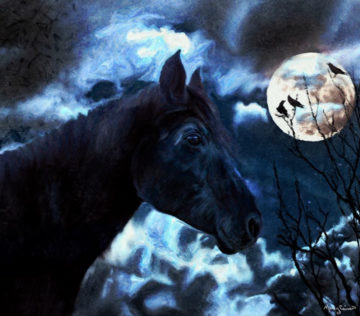
On the 31st anniversary of her stallion Midnight Merlin’s birth, author Linda Kohanov explores the mystical elements of his life and death. “I still don’t understand how what happened came to pass,” she says. “I can only report what happened, in repeated cycles of remembrance and learning, like cycles of moonlight shining over the desert landscape. The moon after all, seems to wax and wane, die and be reborn each month, because it’s reflecting a temporarily hidden sun in relation to the earth’s shadow. Still, midnight travelers don’t need a working knowledge of astronomy for the moon to light their way. And so it is with the invisible, inexplicable forces that all earthly explorers can draw upon to reach their goals, and even help change the world, before cutting edge science, let alone culturally accepted thought, can even begin to catch up.”
In the following essay, written on May 23, 2017, Linda reflects on events that continually inspire her to embrace the paradox and mystery of life:
Memorial Day
May 23 is a personal Memorial Day: an intense confluence of memories and synchronicities. It is the birthday of one of my greatest teachers, the stallion Midnight Merlin. And even though he is no longer with us physically, he still touches my life in profound ways every day, as I live and work with his sons Spirit, Indigo Moon and Orion, and his granddaughter Artemis, and as I continue to share Merlin’s many unexpected lessons and stories in workshops, books, articles, and lectures.
May 23 is also the day my beloved mother Martha Kohanov died in 1999. It is no small coincidence that the small life insurance policy she left to our family allowed me to buy Merlin in 1999 at a time when my husband and I were struggling financially. I only found out after I received Merlin’s registry papers later that same year, that my mother had in fact died on the stallion’s 13th birthday.
Today, on the 18th anniversary of my mother’s passing and the 31st anniversary of my stallion’s birth, I’d like to explore the mysteries of life and death by sharing an updated version of a tribute I wrote for Merlin when he also left this world in 2009. May it perhaps inspire you to revisit the profound, sometimes brutal mysteries of your own biography and encourage us all to see life’s challenges from a wider perspective.
A Tribute to Midnight Merlin
When I met Merlin in 1999, he was a stunning black stallion with tremendous untapped potential, but early training made him so dangerous and unpredictable that he had to be kept in an isolated corral. Some techniques used in training show horses are the same techniques that were traditionally used for warhorses. In the wrong hands, these practices become abusive, creating volatile, rage-filled horses. In rehabilitating Merlin, I realized that he had many of the symptoms that veterans with PTSD report, a frightening combination of power, energy and hyper-vigilance leading to explosive outbursts of anger followed by an almost unbearable combination of vulnerability, confusion and shame for his actions. He threatened my life several times, but something in his eyes kept me from giving up on him.
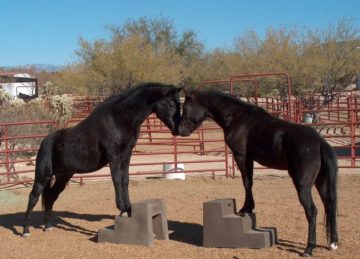 In teaching the frustrated stallion how to respectfully integrate into a herd, I tapped what I came to call a “fierce sensitivity” in myself and in my mares Rasa and Comet, who would become his mates and his ultimate healers. Together with my colleague, an experienced and daring horse trainer named Shelley Rosenberg, we learned to set strong yet compassionate boundaries with Merlin while helping him break the cycle of rage and shame that kept him isolated from humans as well as other horses. Over time, we figured out how to teach these same skills to people through activities with gentler, specially trained horses. (My books The Tao of Equus, Riding between the Worlds, Way of the Horse, and The Power of the Herd all chronicle different stages of Merlin’s tempestuous shift from dangerous stallion to loving mate, proud father, and finally teacher of human students.)
In teaching the frustrated stallion how to respectfully integrate into a herd, I tapped what I came to call a “fierce sensitivity” in myself and in my mares Rasa and Comet, who would become his mates and his ultimate healers. Together with my colleague, an experienced and daring horse trainer named Shelley Rosenberg, we learned to set strong yet compassionate boundaries with Merlin while helping him break the cycle of rage and shame that kept him isolated from humans as well as other horses. Over time, we figured out how to teach these same skills to people through activities with gentler, specially trained horses. (My books The Tao of Equus, Riding between the Worlds, Way of the Horse, and The Power of the Herd all chronicle different stages of Merlin’s tempestuous shift from dangerous stallion to loving mate, proud father, and finally teacher of human students.)
Merlin had the most profound affect on veterans, who very much 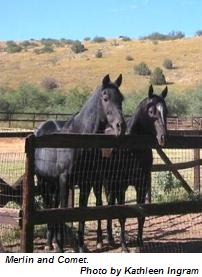 related to his story. They observed that it was a more difficult, arguably heroic act for Merlin to learn a new way of relating to the world than it was for him to keep reacting out of fear and anger. Seeing this powerful stallion living peacefully with his mares and working with his son Spirit, who sired his own daughter in 2008, would bring tears to their eyes, filling them with tremendous respect for their own challenges in returning to life back home. The fierce sensitivity I engaged with Merlin turned out to be an essential ingredient for family members to adopt in order to help their loved ones transform the intense emotional pain that many military service men and women feel in the wake of the all too common traumas of combat.
related to his story. They observed that it was a more difficult, arguably heroic act for Merlin to learn a new way of relating to the world than it was for him to keep reacting out of fear and anger. Seeing this powerful stallion living peacefully with his mares and working with his son Spirit, who sired his own daughter in 2008, would bring tears to their eyes, filling them with tremendous respect for their own challenges in returning to life back home. The fierce sensitivity I engaged with Merlin turned out to be an essential ingredient for family members to adopt in order to help their loved ones transform the intense emotional pain that many military service men and women feel in the wake of the all too common traumas of combat.
When Merlin died in February of 2009, the outpouring of cards and emails from around the world was startling. His legacy continues to expand through his children. Spirit and his brothers ultimately benefitted from their father’s journey to greater health and balance. With the cycle of isolation, rage, shame and abuse broken, Merlin’s sons—and his granddaughter—are among the bravest, most spirited and personable horses you’ll ever meet. They now teach people from around the world how to move through their own personal challenges and imagine new ways to transform society and nourish future generations.
Pondering the Mystery
The impact Merlin had on people from all walks of life was significant. Though we lived out in the middle of the desert, twenty-eight people made the effort to attend his memorial service in February 2009. We received well over three hundred emails and cards within the first month.
I was astonished, and deeply touched, by the impact Merlin had. I was also shaken and inspired by the powerful synchronicities surrounding his death, a few of which I will share with you here.
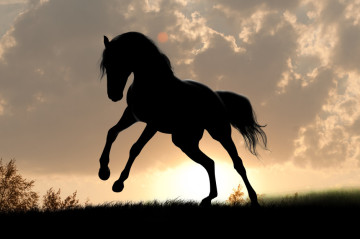 The end to Merlin’s earthly journey was sudden. He loved sparring with his son Spirit, which was fine when they were turned out together under supervision. Yet whenever Merlin got away from his handlers, he would immediately rush over to Spirit and try to play over the fence, an incredibly dangerous game. On February 9, he somehow escaped from his sturdy corral deep in the night. Without anyone around to stop these stallion shenanigans, the two were obviously taking significant risks. At some point, Merlin reared up, broke the fence and was impaled. We are reasonably sure he died instantly, as there wasn’t much blood that escaped from this extreme wound. The next morning, staff members Sue Smades and Shelley Rosenberg found Spirit, his mare Panther, and their daughter Artemis standing quietly beside Merlin’s body. They had not disturbed their patriarch in any way.
The end to Merlin’s earthly journey was sudden. He loved sparring with his son Spirit, which was fine when they were turned out together under supervision. Yet whenever Merlin got away from his handlers, he would immediately rush over to Spirit and try to play over the fence, an incredibly dangerous game. On February 9, he somehow escaped from his sturdy corral deep in the night. Without anyone around to stop these stallion shenanigans, the two were obviously taking significant risks. At some point, Merlin reared up, broke the fence and was impaled. We are reasonably sure he died instantly, as there wasn’t much blood that escaped from this extreme wound. The next morning, staff members Sue Smades and Shelley Rosenberg found Spirit, his mare Panther, and their daughter Artemis standing quietly beside Merlin’s body. They had not disturbed their patriarch in any way.
There was no sign of painful struggle. The wind was still that morning. The sound of water bubbling softly from nearby Apache Spring offered a gentle requiem. Merlin actually looked peaceful, as did the rest of the herd—uncannily so, as if they had all agreed ahead of time that this would be a good day, and way, to die.
Over the next few days, Merlin initiated the entire staff into some profound mysteries that will take time to process and translate into language. However, some words I had written the year I met him a decade earlier serendipitously came back to me the night before his memorial service. Titled simply “5-8-99,” this unpublished essay was composed during a plane ride on that date. I was returning from Ohio, where I’d been helping my mother Martha Kohanov face a serious cancer diagnosis. I knew she was preparing to leave this world.
These musings about life and death were written shortly before The Tao of Equus had been accepted by a publisher. In the subsequent frenzy of completing my first book, I had lost the essay, forgotten about it even, until Sarah Barron, one of our advanced instructors, found it stuffed between the pages of a book in my library during a workshop held the very week Merlin passed away. I still cannot fathom how slim the chances were that Sarah would find this long-forgotten essay the night after Merlin died, an essay that foreshadowed key details of Merlin’s death ten years before, an essay that was written the year I met him, the year my mother died on the stallion’s 13th birthday.
Yin and Yang, Dark and Light
It’s fitting that the essay was found in a book on Taoism. My thoughts had a decidedly Taoist flavor on May 8, 1999 as I moved back and forth between the opposites of light and shadow, fortune and tragedy, day and night. Already I sensed that the abandoned stallion I had just met would be one of my greatest teachers in this respect.
I would like to share two excerpts from this strange essay with you: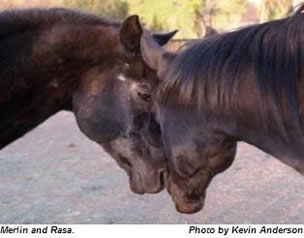
My sister and her daughter drop me off at the airport. We seemed to be running late, but the timing couldn’t have been better. No line at the American Airlines desk. Plenty of time to have a drink at the pub across from Gate A-1.
I sit down and order a dark and murky brew. The man sitting next to me is trading business cards with a stranger. “It’s called the Horseshoe,” he says, and though I catch this phrase completely out of context, I know his words can only bring good luck.
A week ago, we were in the abyss, my mother and I. Neither one of us was being very patient with the process. Sometimes the place between life and death seems more cruel than the end of this existence; the path back to health feels more treacherous than surrendering to the whims of illness. Is there wisdom behind all this suffering? And if so, how do we tap the bittersweet nectar at the center of each difficulty? I step on the plane and consider the possibilities.
I have learned from fear as much as I have reaped from security. I have seen the face of God in agony as well as ecstasy. I have gained immeasurable strength from recognizing my own weaknesses. These are the perfect flaws, the prisms through which the pure white light of the divine divides into the rainbows that hang above our earthly sphere, the crystallized tears that inspire us to give voice to what we feel, quite often only because we’re afraid there may be no time left to say it.
The Grim Reaper, at his best, becomes the One-Eyed Jack, the wild card that helps us win the game, if only we have the skill to use it to our greatest advantage. Sometimes the threat of death tricks us into really living. Other times, the only way to beat the house is to lay our cards on the table and cash in that pile of chips before we loose them to the habits of ambition. I’m not quite sure how my mother will play this crucial hand. Death itself is a collaborator now, though it has taken me half a lifetime to let go of my fears and stare into this mystery.
The essay is filled with references to a horse I had just started working with, a stallion named Midnight Merlin. A few days before I left my mother’s side, he showed up in a dream. It felt important at the time, but the imagery would not become fully decipherable until Merlin’s own death ten years later, though this synchronicity only adds to the mystery.
As I fly through the sky, I remember the moment the doctors admitted my mother is dying of melanoma, the dark shadow that solidifies in the presence of too much sun, the black name that challenges every thought and every breath she takes. I may drop out of the sky at any moment. These are the dramas that angels watch on television, and they demand a happy ending. Still, good fortune to them has no earthly limit. The best stories are those peppered with tragedies overcome in this life, or the next, but it’s a rare mortal whose faith extends beyond that threshold.
Soaring toward my desert home, my husband and my horses, I’m left holding onto the fragments of a dream: Meteors are shooting across the sky. The mask of a One-Eyed Jack is impaled on a post next to a bubbling spring. My mother sits in a wheelchair, poised at the edge of all this madness as four rattlesnakes pass before her carrying off Merlin’s old shoes. When I first met the neglected night-haired stallion, he had outgrown his thick metal arches to such an extent that he limped around for hours after they were finally removed. Rearing in protest, he reminded us both of the power behind the pain.
Falling stars, a perversely comical death mask impaled on a post, near a bubbling spring, venomous snakes, and lame black horses. We have the potential to draw more strength from these nocturnal images than our cultural idols would prefer us to consider. The shoe that no longer fits the horse becomes a charm when hung above the door. The rattlesnake poison that kills becomes the main ingredient in the tonic designed to heal. The old skin that begs to shed always feels like death, but new growth cannot assert itself as long as we hold onto our dry, scaly obligations.
I hear it’s raining at my mother’s house in Ohio. I search my purse for a cheap pair of sunglasses as the plane carries me toward the clear skies of the coming desert. Gazing across hundred acre farms that look like postage stamps, I catch a glimpse of a memory not my own that swirls and sparkles and turns inside out in the 10,000 joys and 10,000 sorrows of a setting sun:
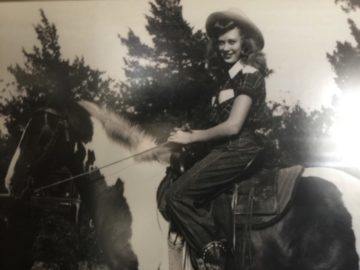
My mother is a child being chased across an Alabama golf course by a trio of mischievous boys. They’re carrying a dead water moccasin, threatening to wrap it around her neck. After 60 years of running, she suddenly stops, turns to face her tormentors and the dreaded black serpent dissolves into a magnificent rainbow, arching above her in the sky like the door to another dimension.
I wrote this a couple of weeks before I got back on another plane, back to Ohio, back to my mother’s side to witness her last breath. Martha Lou Patterson Kohanov passed away on May 23, 1999. The small insurance policy she left allowed my sister to adopt a child in China. And though my husband and I were struggling, literally putting our mortgage on a credit card at the time, I used my portion of the inheritance for something whimsical, perhaps even foolish. I bought Midnight Merlin. When his former owner handed me his Arabian Registry papers a few months later, I couldn’t help notice that the stallion was born on May 23, 1986. My mother had died on his 13th birthday.
Dramatic Exit
In life, Merlin was larger than life. His influence expanded exponentially as he exited this world with a massive blast of energy, leaving in his wake a surge of inspiration and insight. I missed him, most certainly, but I got the chance to say tearful goodbyes to him repeatedly over the years, as he was close to death a number of times, always making a miraculous recovery, the most impressive of which was chronicled in Riding between the Worlds.
On February 9, 2009, he played a different hand, one that, as my strange synchronistically recovered dream suggests, had been in the cards all along. He literally impaled himself on a post—right next to the bubbling waters of one of the few springs in the desert outside Tucson, the spring that is the namesake of Apache Springs Ranch. If that was not enough, the number 23 again came into play. Merlin was 23 years old when he left this world.
Louise Poppema, who had attended a Keeper of the Mysteries workshop held at Apache Springs Ranch a few months earlier, was among many people who offered profound words of comfort upon hearing the news:
“It seems, perhaps, that as in life, Merlin made a proud and wild choice in the manner of his passing. No lingering frailty, no extended downward spiral. I hope that I, too, may be so fortunate as to die quickly while acting in a manner so true to my nature.”
Tears for Passing Things
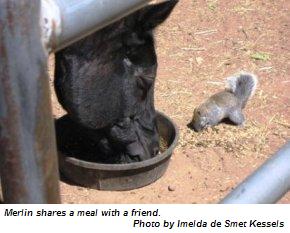 In looking back on my memories of Merlin, I always come back to one powerful experience I’ve never shared in any of my books, the memory of an uncanny kindness Merlin showed me that first summer. The event took place a month after my mother died, and I was, as a result, able to officially bring Merlin into my herd. He was an imposing and frightening sight back then, attacking anyone who tried to put a halter on him, often reacting as if he’d been shocked by a cattle prod when people reached out to touch him. Yet there was another, equally potent side to Merlin: He was the one who first showed me that fierceness and sensitivity can work together, must work together, if we are to heal the injustices of the past.
In looking back on my memories of Merlin, I always come back to one powerful experience I’ve never shared in any of my books, the memory of an uncanny kindness Merlin showed me that first summer. The event took place a month after my mother died, and I was, as a result, able to officially bring Merlin into my herd. He was an imposing and frightening sight back then, attacking anyone who tried to put a halter on him, often reacting as if he’d been shocked by a cattle prod when people reached out to touch him. Yet there was another, equally potent side to Merlin: He was the one who first showed me that fierceness and sensitivity can work together, must work together, if we are to heal the injustices of the past.
In the weeks following my mother’s death, I was overtaken by a numbness I couldn’t shake, similar I supposed to the numbness some returning soldiers feel. As one of my mother’s primary caretakers, one who’d held her hand as she endured incredible pain during those final days, I’d somehow suspended my own grief and horror in order to best serve her needs and stabilize our extended family.
 A month after the funeral in 1999, I was doing some simple ground work with Merlin. A full moon was rising over the mountains, and the world, it seemed, was at peace. Suddenly, Merlin experienced an incredible surge of energy. Bucking and kicking out sideways, he caught me squarely in the lower abdomen. I let go of the lead rope, doubling over in pain. Yet even as the physical sensation subsided, the tears came pouring out of me, tears I hadn’t been able to cry the whole time my mother was dying. It was if Merlin had flipped a switch in me. The stallion began to lick and chew profusely, equine signs of release. Slowly, gently, he walked over and touched my hand. Without a second thought, I put my arms around him and sobbed into his neck. Both of us, it seemed, needed to grieve the pain we had experienced and witnessed.
A month after the funeral in 1999, I was doing some simple ground work with Merlin. A full moon was rising over the mountains, and the world, it seemed, was at peace. Suddenly, Merlin experienced an incredible surge of energy. Bucking and kicking out sideways, he caught me squarely in the lower abdomen. I let go of the lead rope, doubling over in pain. Yet even as the physical sensation subsided, the tears came pouring out of me, tears I hadn’t been able to cry the whole time my mother was dying. It was if Merlin had flipped a switch in me. The stallion began to lick and chew profusely, equine signs of release. Slowly, gently, he walked over and touched my hand. Without a second thought, I put my arms around him and sobbed into his neck. Both of us, it seemed, needed to grieve the pain we had experienced and witnessed.
Sunt lacrimae rerum. “Tears for passing things.” That’s how the Roman poet Virgil characterized the transformative power of grief over two thousand years ago. His most famous epic, The Aeneid, follows the adventures of the Trojan refugee Aeneas who leads a few ships of his fellow survivors to a new life in Italy after their city is destroyed. A furious storm knocks them off course, driving them to the shores of Libya. In my first book, The Tao of Equus, I shared how this ancient story of an ancient hero came to me as a result of working with Merlin. But the same key scene from The Aeneid came back to inform my own journey when Merlin held me through the grief of my mother’s passing: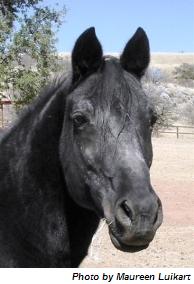
After making that emergency landing in Libya, the defeated hero Aeneas stumbles across an elegant shrine to the mother goddess Juno, where he’s amazed to discover a magnificent depiction of the Trojan Wars painted on the walls. Aeneas drops to the ground and weeps, touched by the fact that no matter who had won or lost, who had lived or died, these events were deemed important enough to memorialize in the embrace of a goddess, allowing the embittered warrior to cleanse his soul and witness his trials from a more exalted perspective.
Uncannily, the story specifies that the shrine of the goddess had been built on the grave of a fierce warhorse.
The bond Merlin and I felt was solidified the night he held the space for me to finally release my own tears of loss and helplessness.
The next day I had a beautiful purple heart-shaped bruise in the center of my womb where the stallion had “accidentally” kicked me the night before. The mystery continues to haunt, inspire, and nourish me to this day.
Midnight Merlin, you have proven over and over again to be a warrior, a sage, and a magician in ways my limited human mind could never have imagined. Now you are a legend.
May your story live on, touching our lives with magic wherever and whenever someone tells it.
May you fly free through new adventures of the spirit, my teacher, my dear friend.
You will not be forgotten.